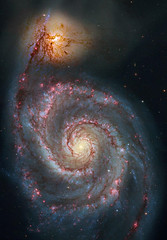[Bonus points to any middle-aged readers who recognize the title*.]
I still get a thrill every time I see a particularly beautiful image of an astronomical object. But there are some that transcend that beauty, adding a dimension of what-the-what? that makes them just that much cooler.
Like, say, this amazing image of the core of the nearby galaxy M51, taken using Hubble:
[Click to enwhirlpoolenate, or grab the high-res 2 Mb version.]
That is not the swirling drain of despair and fear leading into the mouth of hell. Just to be clear.
What it actually shows is the dust in the inner region of M51, clearly tracing the spiral arms of this magnificent galaxy. The image is false-color, and where it’s brighter there’s more dust (or the dust is being lit up more brightly by nearby stars). You can see the dust is clumpy, too, showing where there are clusters of stars illuminating the dust. Astronomers expected the dust distribution to be somewhat clumpier, but the galaxy had a different idea. It may be smoother due to a close pass by a companion galaxy (well off-screen in this close up shot – we’re seeing the inner 18,000 or so light years here) which disturbed it and prevented dust clouds from getting too big.
How this image was made is interesting, too. Above is a side-by-side shot of the same region. The left image is a visible light picture taken by the Advanced Camera for Surveys (ACS), and on the right is the infrared one, taken using the NICMOS camera. The ACS image shows stars, gas, and some dust at the core of the galaxy. The original NICMOS infrared image had stars in it too, but by carefully aligning and scaling the ACS image, astronomers could subtract the stars from the NICMOS picture, leaving just the dust behind (in the bigger version you can see the black dots where stars were removed). I’ve done this sort of work myself with Hubble pictures, and to say it’s painstaking is severely underestimating the pain that is staked.
 The infrared image was taken at a wavelength of 1.6 microns – a little more than twice the wavelength of the reddest light the eye can see – where warm dust glows well. M51 is a bright, nearby galaxy, easily seen in even smallish telescopes, so it’s a very well studied object. The thumbnail image here (from Hubble, and was one of my Top 14 pictures of 2010) shows the whole thing, and you can see it’s a big ol’ spiral, with a yellowish irregular galaxy nearby – it’s that little galaxy with which the spiral is interacting, as mentioned earlier.
The infrared image was taken at a wavelength of 1.6 microns – a little more than twice the wavelength of the reddest light the eye can see – where warm dust glows well. M51 is a bright, nearby galaxy, easily seen in even smallish telescopes, so it’s a very well studied object. The thumbnail image here (from Hubble, and was one of my Top 14 pictures of 2010) shows the whole thing, and you can see it’s a big ol’ spiral, with a yellowish irregular galaxy nearby – it’s that little galaxy with which the spiral is interacting, as mentioned earlier.
I’ve seen M51 through a good ‘scope, and the spiral pattern can be seen pretty well. What’s amazing is how well-ordered the spiral arms are, traceable in the Hubble image right down to the very heart of the galaxy! I’m used to the visible light images (like the ACS one above) where you kindof lose the arms in the general glow of the stars in the galactic nucleus. Once that’s removed, you can see the spiral pattern goes all the way down. I imagine this observation will be a boon to theoretical astronomers, who are still having headaches over how spiral arms form and maintain their shape. The basics are pretty well-understood, but details are always a problem, and such a fine, high-resolution image will help the theoreticians constrain their models.
Image credits: NICMOS Image: NASA, ESA, M. Regan and B. Whitmore (STScI), and R. Chandar (University of Toledo); ACS Image: NASA, ESA, S. Beckwith (STScI), and the Hubble Heritage Team (STScI/AURA); full image: NASA, Hubble Heritage Team, (STScI/AURA), ESA, S. Beckwith (STScI). Additional Processing: Robert Gendler
Related posts about M51 and spiral arms:
- Revisiting the Whirlpool
- Herschel opens its eye
- Barred for life
- Top 14 astronomy pictures of 2010
* Bonus points only redeemable in M51.